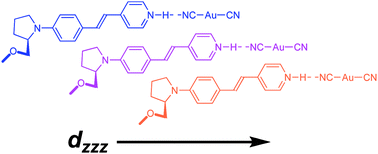Three salts built up from (E)-4′-(dimethylamino)-stilbazolium (DMAS)H+, (E)-4′-(diethylamino)-stilbazolium (DEAS)H+, (E)-4′-{2-(methoxymethyl) pyrrolidinyl}-stilbazolium (MPS)H+, and gold cyanide as a counter-ion, are reported. The crystal structures have been solved for (DEAS)H+ Au(CN)2− (Cc space group), and for (MPS)H+ Au(CN)2− (P1 space group). The semi-empirical (ZINDO) calculated static hyperpolarizability (β0) of (MPS)H+ is equal to 147 × 10−30 cm5esu−1, in solid state, which is 25% higher than that of the cation of the well known (E)-4′-(dimethylamino)-methylstilbazolium tosylate (DAST). (MPS)H+ Au(CN)2− exhibits a unique crystal structure in which the cations are perfectly aligned. This combination of large hyperpolarizability and strict 1-dimensional character leads to a giant dzzz quadratic susceptibility (χ(2)) tensor component estimated between ∼4500 pm V−1 (∼11 × 10−6 esu) and 12 400 pm V−1 (∼30 × 10−6 esu) at 1.064 μm, by a confocal μ-SHG technique. The use of such material in ultra-thin devices is critically evaluated.

You have access to this article
 Please wait while we load your content...
Something went wrong. Try again?
Please wait while we load your content...
Something went wrong. Try again?


 Please wait while we load your content...
Please wait while we load your content...